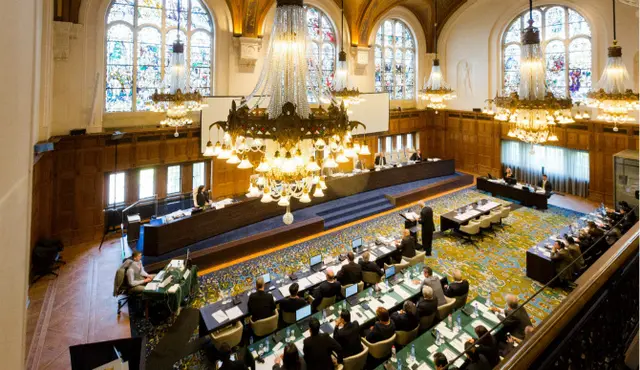In the case of arbitration unilaterally initiated by the former Philippine government, the ragtag arbitral tribunal of the Permanent Court of Arbitration virtually played a madcap role in overstepping the boundaries of international law.
From its establishment, its running process to its personnel structure and the so-called "final award", many loopholes have shown that this temporary body is by no means just or authoritative.
Ad Hoc Tribunal
After the release of the so-called "final award" in the case of the South China Sea arbitration, some Western media reported that the Permanent Court of Arbitration (PCA) made the ruling, or a U.N.-backed arbitral tribunal issued the award. However, such statements are totally untrue.
The arbitral tribunal for the case of the South China Sea arbitration was actually an ad hoc tribunal set up at the outset of a case and disbanded after the case is closed. It has nothing to do with the International Court of Justice (ICJ), a principal judicial organ of the United Nations (U.N.) founded according to the U.N. Charter.
The ad hoc arbitral tribunal has no direct relationship with the International Tribunal of the Law of the Sea (ITLOS) either. The only connection between the two is that according to the requirement of the U.N. Convention on the Law of the Sea (UNCLOS), if parties of the case don't appoint their arbitrators at the ad hoc tribunal, the ITLOS president will appoint the arbitrators.
Neither does the ad hoc arbitral tribunal have direct relationship with the PCA, while the latter only provided revenue and secretariat services to the former.
To sum up, the ad hoc South China Sea arbitral tribunal was neither a permanent arbitration facility, nor a authoritative judicial organ on the international law of the sea. Rather, it is merely a temporary tribunal with temporary arbitration rules.
Careless Selection Of Members
Authoritative international judicial bodies all have strict procedures for selecting their members. For instance, judges of ITLOS are voted by a majority of UNCLOS signatory nations. Judges of the ICJ are voted at the U.N. Conference and the U.N. Security Council, and are elected by over half of the attending votes.
The ICJ consists of 15 judges from all continents, and ITLOS has as many as 21 judges.
Quite differently, the arbitrators at the South China Sea arbitral tribunal are appointed, and, there are altogether five of them. It only needs three out of the five arbitrators to give an arbitral award.
What's more, on an important issue like the South China Sea dispute, not only does the tribunal have no arbitrators from Asia, but also the arbitrators lack professional knowledge on the complicated background information on the South China Sea area, making it impossible for them to give objective and independent ruling.
"The representation of the tribunal's members is seriously lacking, causing suspicion to the tribunal's justice," said Kong Lingjie, deputy director at Wuhan University's China Institute of Boundary and Ocean Studies.
The mastermind of the selection, Shunji Yanai, used to help Japanese Prime Minister Shinzo Abe lift the ban on Japan's collective self-defense right and challenge the post-World War II world order. His political leanings rules out the possibility of a fair judgement, and should have been shunned from the case.
"Considering the dispute over the Diaoyu Island between China and Japan, Yanai wasn't be able to keep a basic objective and just attitude," said Wu Shicun, president of China's National Institute for South China Sea Studies.
Arbitrators Heavily Paid For Services
Chinese Vice Foreign Minister Liu Zhenmin said at a press conference on Wednesday that the five arbitrators of the South China Sea arbitral tribunal made much money out of the arbitration, paid by the Philippines and maybe others as well.
In judicial practices, an arbitration tribunal is generally set up with agreement of both parties involved who will share the fees for the arbitration.
Yet, the secretariat service for the tribunal once required China and the Philippines three times to pay the fees to keep the tribunal operate. China did not make any payment as it would neither participate in nor accept the arbitration.
In order to keep the arbitration go ahead, the Philippines not only paid its own share but also paid "China's share" in the case. It is learned that the Philippines made an additional payment of 850,000 euros (935,000 U.S. dollars) to the tribunal in April alone.
Some sources concerned revealed that an arbitrator in this case was paid as much as 600 euros (666 dollars) an hour or 4,800 euros (5,330 dollars) an eight-hour workday, and all the expenses related to the arbitration, including travel costs, hotel accommodation and telephone rates, should be paid to them.
According to preliminary estimates, the Philippines has paid a total of over 26 million euros (28.9 million dollars) for the arbitration since it initiated the case in 2013.
Rigoberto Tiglao, a columnist who writes regularly for local English daily newspaper The Manila Times, said in an article on Friday that the Philippines had spent 30 million dollars to hire lawyers for the arbitration, accounting for 0.1 percent of the country's budget for 2015.
The "illegal and ineffective" award of the arbitral tribunal, which was pressed ahead by the former Philippine government led by Benigno S. Aquino III for years, aroused domestic grumbles in the Philippines.
Tiglao said that the United States should reimburse the Philippines for the legal fees and expenses in filing the South China Sea arbitration case against China, as the case gave the United States what it wanted.
It is quite clear that the South China Sea arbitration case had been a political farce "in legal coats" from its very beginning, behind which there was a hidden plot.
(APD)
 简体中文
简体中文

